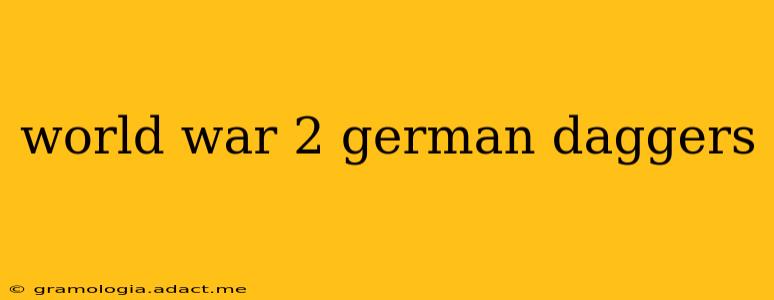The Third Reich's reign left behind a chilling legacy, including a vast array of military artifacts. Among these are the German daggers of World War II, objects that hold a complex blend of historical significance and controversial appeal. This guide delves into the history, types, and identification of these daggers, offering insights for collectors and history enthusiasts alike.
What types of German daggers were used in WWII?
The German military used a variety of daggers during World War II, each with specific purposes and designs. These weren't just for show; they served practical roles in both formal settings and combat. Key types include:
-
SA (Sturmabteilung) daggers: Associated with the Nazi paramilitary organization, these daggers often feature the SA emblem and are highly sought after by collectors, though their association with a violent and oppressive organization makes their ownership a sensitive subject.
-
SS (Schutzstaffel) daggers: Similar to SA daggers, but with the SS runes and often more elaborate designs, these daggers are also highly collectible, again with the caveat of the SS's notorious history.
-
DAK (Deutsches Afrikakorps) daggers: Designed for use in the North African campaign, these daggers often feature unique characteristics reflecting the harsh desert environment.
-
Kriegsmarine (Navy) daggers: These daggers showcase nautical themes and variations in design, reflecting the specific needs and traditions of the German Navy.
-
Luftwaffe (Air Force) daggers: Similar to the Kriegsmarine daggers, Luftwaffe daggers often feature aviation-related insignia and designs.
-
Heer (Army) daggers: The most common type, Heer daggers display a range of designs, often simpler than those of the other branches.
What makes a WWII German dagger valuable?
The value of a WWII German dagger is influenced by several factors:
-
Rarity: Certain models, particularly those from specific units or with unique markings, are rarer and therefore more valuable.
-
Condition: The condition of the dagger, including the blade, scabbard, and fittings, significantly impacts its value. A well-preserved dagger in its original condition will fetch a higher price than a damaged one.
-
Authenticity: Counterfeit daggers are prevalent, so verifying authenticity through expert appraisal is crucial. Features such as maker's marks and the quality of craftsmanship can help determine authenticity.
-
Provenance: A documented history of ownership can increase the value, especially if it can be traced back to a specific individual or unit.
How can I identify a genuine WWII German dagger?
Identifying an authentic WWII German dagger requires careful examination and expert knowledge. Key aspects to consider include:
-
Maker's Marks: Authentic daggers usually bear maker's marks, which can be used to verify their origin and authenticity.
-
Materials: The materials used in construction – including the blade steel and scabbard materials – should be consistent with the era and the type of dagger.
-
Construction Quality: Authentic daggers generally exhibit superior craftsmanship compared to reproductions.
-
Insignia and Markings: The markings and insignia should be correctly applied and consistent with the period and the specific unit or organization. Incorrect or poorly executed markings often point to a fake.
Are WWII German daggers legal to own?
The legality of owning WWII German daggers varies depending on your location. Some countries have strict regulations or outright bans on the possession of Nazi-related artifacts. It's crucial to research and understand the laws in your area before acquiring or possessing any such items.
What should I look for when buying a WWII German dagger?
When purchasing a WWII German dagger, proceed with caution. Always deal with reputable dealers, and if possible, obtain a certificate of authenticity from a qualified expert. Thoroughly inspect the dagger for any signs of damage, repair, or alteration. Be aware of the ethical implications of collecting such items and the sensitivities surrounding their historical context.
This guide offers a starting point for understanding the intricacies of WWII German daggers. Further research and consultation with experts are recommended for serious collectors. Remember that the historical context and ethical implications should always be considered when dealing with these artifacts.
